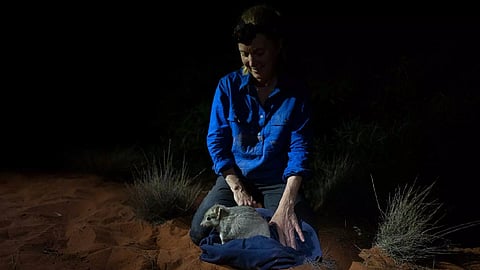

Katherine Moseby wanted to be clear: She does not hate cats. “They’re a wily beast,” she said, as her truck rumbled down a desert road. “But I respect them. They’re pretty incredible animals. Amazing hunters. Very smart.” That was precisely the problem, said Dr. Moseby, the principal scientist and co-founder of Arid Recovery, a conservation nonprofit and wildlife reserve in South Australia. Cats are not native to Australia, but they have invaded nearly every corner of the country. She gestured out the window at the dusty, red expanse, which bore few signs of life. But feral cats were absolutely out there, Dr. Moseby said, and they had a taste for the tiny, threatened marsupials that lived at Arid Recovery.
Even with extensive fencing, keeping the cats at bay requires constant vigilance. Over the previous few nights, a “pest control contractor” — a robustly bearded sharpshooter equipped with an all-terrain vehicle and powerful spotlight — had been riding through the Arid Recovery reserve, shooting cats. When Dr. Moseby, who is also a researcher at the University of New South Wales, pulled up to the Arid Recovery office a few minutes later, she made her way to a small outbuilding to check on the shooter’s progress. A line of red droplets led down the stone path. “Fresh blood trail’s a good sign,” she said, before pushing open the door.
Inside, the carcasses of more than a dozen cats were piled in a large, shallow tub. The shooter was responsible for four of them, Dr. Moseby said, looking over the animals. The others had been caught over the preceding weeks and were being stored until researchers could examine the contents of their stomachs.
It was a scene to make most any cat lover squeamish, and Dr. Moseby, who grew up with pet cats, once would have been “outraged” by the idea of killing them, she said. But after repeatedly discovering the half-eaten carcasses of greater bilbies and burrowing bettongs, just two of the reserve’s vulnerable residents, she had come to a stark conclusion: “You have to make a choice between cats and wildlife.”
Cats are not villains. But they are hunters, and through no fault of their own they take an enormous toll on the world’s wildlife. They pose an especially acute threat in Australia, which has no native feline species but is home to a menagerie of slow-to-reproduce, snack-size mammals.
“Cats are just catastrophic,” said John Read, an ecologist at the University of Adelaide and Dr. Moseby’s husband. The two founded Arid Recovery in 1997.
Since European settlers, and their cats, began arriving in Australia in the late 18th century, at least 34 species of native mammals have gone extinct. It is the worst mammalian extinction rate in the modern world, and cats have been “a major contributor,” said Sarah Legge, a wildlife ecologist at Charles Darwin University and the Australian National University. “Our fauna just haven’t evolved to cope with cats.”
Pet cats do their share of damage, but the feral cat population is an especially intractable problem. The Australian government has labeled feral cats “a nationally significant pest” and declared “war” on the free-ranging felines more than once. For decades, Drs. Moseby and Read have been on the front lines. They have devoted some of their efforts to developing new tools for reducing the ranks of feral cats. “We need to do it as efficiently and effectively and humanely as possible,” Dr. Read said. “But we need to do it.”
They also know that the cats are too entrenched to eliminate altogether, and that protecting native animals will require more than cat control. After all, there are two sides to the predator-prey relationship. And if cats are in Australia to stay, the bilbies and bettongs will need to find a way to live safely alongside them.